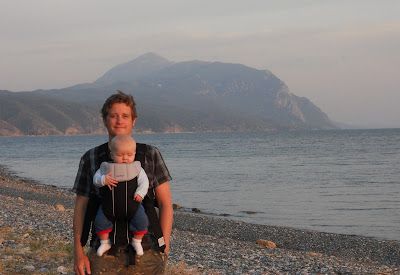Evia is the second biggest island in Greece, though strangely off the tourist map. A mountainous, long strip of land that rises out of the Aegean and straddles the mainland to the East of Athens. I have been coming here for nearly a decade, staying in the quiet green peninsular of Spiada, where Christina’s family have a summer home. Last week I dragged myself from a state of comatose relaxation to check out inland.
The north-western coastal road starts from the small town of Limni, skirting along the steep mountains and cliffs that adjoin the land to the sea. Views across the channel to the mainland are something else. Flat shimmering waters eventually giving way to rows of hills which genlty fade into the haze.
Every so often you come across a village or small town clinging to low-lying fertile ground. At one such village, Rovies, we turned in land and climbed up the winding roads into the forest which covers much of the top of Evia. Mature pine trees and, above 800m, fir. Typically Greek objects pop up along the side of the road. Plastic sacks collecting sap from manmade wounds in the trunks of pine trees – an essential ingredient of retsina. Small bee boxes colour coded to the owner – apparently these are moved around with the seasons to follow the blossoms, each type changing the flavour of the honey.

Sadly, on dodgy bends you invariably find small shrines to car crash victims. these come in various shapes and sizes, with the design of a miniature church on a post being amongst the most common. The Greeks are a passionate people who are known to bend a rule or two. Too much machismo driving and not enough road signs lead to the Greeks having one of the worst road safety records in the developed world. Humbling sights amongst all the beauty.
 THE MONASTERY
THE MONASTERY
Winding our way up the steep valleys we eventually reached the monastery of Osios David. Touristy in summer, but now very peaceful. Turning your back on far reaching views into the forest, you enter through a grand gate into a courtyard surrounded by cloisters covered into carefully managed climbing plants. At the centre of the courtyard is the original sixteenth century Orthodox church. Build in the Byzantine style, every inch of the inside is decoratively covered in mosaics and paintings. Combine all the colour and glitter with incense and incessant chanting of bearded priests and the Greek Orthodox church does a pretty good job of creating that mystical aura which cab be key to capturing worshipper’s imaginations.

On we rolled past and through steeper, higher valleys. With the car windows open the pungent aroma of the landscape wafted into the car. There are many components to the smell. One I think is a hint of oregano, from the wild crops which inhabit the hillsides, but the overwhelming one is freshly heated pine needle. Rather like those little tree shaped smelly things that hang off the mirror in people’s cars, but genuinely refreshing and pleasant.
KOKINOMILIA
After an hour or so, the land flattened out and the forest sporadically opened up for small fields. Along the edges of one such field we were greeted by more quintessential Greek objects – herds of goats jangling their way around. Hmmm, very tasty.
The sharp valleys then re-emerged and we followed the precipitous road up the side of a large hill to the village of Kokinomilia –literally “red apple trees”. Getting out of the car and going for a wander, it felt like we had entered another place or time. Far from the smog of Athens or the gentle chatter of the refined seaside resort, here we could be in any small Balkan village from times past. Craggy houses clinging to the hillside and each other. Small scale agriculture in the gardens with cleverly contorted pieces of rubbish for scarecrows. The small church, friendly wandering mutt and little old lady inviting us in for coffee. Brimming over with charm.
We lunched at
the taverna of the village, owned by Yannis and Kiki. A generous place, serving large portions of bean soup and lokaniko – village sausage. Best of all was the local rose wine. Not only was it light and crisp, but brewed out back. Only that day they were crushing the year’s crop of grapes and they invited us to take a look.

I particularly liked Yannis’ answer to how many people lived in the village – “67, give or take”.
BACK TO THE SEA
A little bit tipsy, we headed down the mountainside and back down the valleys towards the tip of the island. Here countryside makes way for the odd larger town and, shock horror, roads with markings. The views were none the less still stunning as we sped along the coast road back to Spiada. Citrus and fig tree giving way to olive and then sea.
Along winding cliff roads, I fear I failed to take in much of the beauty as drowsiness set in. Fortunately siesta awaited. Then perhaps some beach with the baby...

 But where am I?
But where am I?







